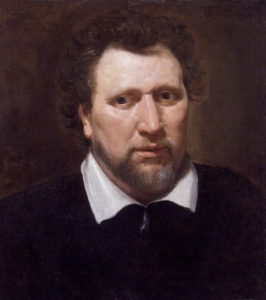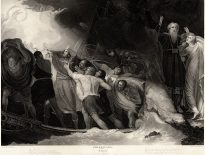 Ben Jonson was a poet and a playwright, born on 11th June 1572, in the reign of Elizabeth I. Jonson was of Scottish descent and throughout his life maintained a great interest in Scotland and his ancestry. He was brought up by his recently widowed mother and had quite a poor upbringing. His father was a clergyman, and thus his wages would not have been substantial, nor would he have left a lot to his wife and son upon his death. When Jonson was still a young boy, his mother re-married, marrying a bricklayer, and they moved to Hartshorn not far from Charing Cross. The bricklayer in question is believed to have been Robert Brett, a man comfortable, if not overly wealthy, who had risen to become master of the Tyler and Bricklayers’ Company by 1609.
Ben Jonson was a poet and a playwright, born on 11th June 1572, in the reign of Elizabeth I. Jonson was of Scottish descent and throughout his life maintained a great interest in Scotland and his ancestry. He was brought up by his recently widowed mother and had quite a poor upbringing. His father was a clergyman, and thus his wages would not have been substantial, nor would he have left a lot to his wife and son upon his death. When Jonson was still a young boy, his mother re-married, marrying a bricklayer, and they moved to Hartshorn not far from Charing Cross. The bricklayer in question is believed to have been Robert Brett, a man comfortable, if not overly wealthy, who had risen to become master of the Tyler and Bricklayers’ Company by 1609.
Ben Jonson attended a small school near Hartshorn Lane, learning to read and write. At approximately the age of seven, he was sent off to Westminster School and studied under William Camden, the school’s second master. Jonson evidently had a positive experience learning under Camden, speaking of him as a ‘friend for ever.’ At Westminster, he learned the art of rhetoric and was educated in the Classics, learning to translate Greek and Latin into English. Furthermore, Camden also encouraged his pupils to create their own prose in English, something which would have a profound effect on young Ben Jonson.
According to Thomas Fuller, churchman and historian, Jonson was admitted into St John’s College, Cambridge, but had to rescind his place there due to a lack of funds. Following his return from Cambridge, he was apprenticed to his stepfather where he aided in bricklaying in Lincolns Inn. Problematically for historians, however, Jonson’s name does not appear in the records of the college or the university. However, Fuller’s local knowledge of Cambridge does make his account credible and there is a request from the president of the college Robert Lane in 1615 that Jonson ‘penne a dyttye’ to celebrate the visit of James I to the college in that year.
Following what we believe was a brief stint at Cambridge, Jonson entered into the family business of bricklaying, and apparently did so grudgingly. Taunts about Jonson’s work as a bricklayer and his low class would dog him throughout his life. However, throughout his life, he continued his affiliation with bricklaying and his stepfather’s business. Accounts from the Tylers’ and Bricklayers’ Company show Jonson making payments to the company from around 1595 until as late as 1611, when Jonson was at the height of his dramatic career. Guild membership in that era was an important measure of social standing, and when Jonson was welcomed into Edinburgh in 1618, it was as a guildbrother, not as a successful playwright. However, in the early 1590s, we know that Jonson left his work as a bricklayer and joined the English forces which were being shipped to the Low Countries.
After his time as a soldier and his return to England, Jonson entered into the theatre, although the date of this is unclear. It is believed that he acted and wrote in the Green Curtain, a playhouse somewhere near Shoreditch. It is said of Jonson that he was a much better writer than actor, and as such, when he had established himself in the theatre business, he gave up acting altogether to focus on his writing. In November 1594, Jonson married Anne Lewis in a church near London Bridge. Not much is known about his marriage save that it was a relatively unhappy one. In 1597, Jonson’s play ‘The Isle of Dogs’ is speculated as giving great offence to the court of Elizabeth I and as such in July of that year, the London theatres were all ordered to close. Jonson was arrested and imprisoned and charged at Greenwich with mutinous behaviour. It seemed that Jonson was carving out quite the reputation for himself in his early theatrical years. Jonson was released on the 2nd October and days later plays were performed at the Rose Theatre despite the embargo.
Jonson’s rise to fame came in 1598 when his play ‘Every Man in his Humour’ was performed at the Curtain Theatre by Shakespeare’s own company and featured Shakespeare himself. It is this witty, skilfully composed play which established Jonson as the new ‘playwright on the block’ so to speak, with a new genre of humour coming to the foreground of comedic drama. However, with this wave of success came notoriety once again when Jonson was arrested for manslaughter, after killing the actor Gabriel Spencer in a duel. Jonson’s own account of the arrest details that he was ‘almost at the Gallowes’ and that he escaped by reading Psalm 51:1, dubbed the neck –verse. Jonson had his goods confiscated and he was branded on the thumb, the mark for a convicted felon. Despite his notoriety, his play Every Man in his Humour’ was performed at the Globe Theatre late in the year 1599 and at court at Christmas that same year. The court performance was not particularly successful and Jonson was made to revise the play prior to its publication in 1616. Jonson was not afraid however to offend other playwrights, frequently satirising and mocking them in his dramas. His reputation is also constantly compared to that of Shakespeare, and the two are often thought to have been bitter rivals.1
When Elizabeth I died in 1603, Jonson made no attempt to mourn her passing, and following the accession of James I, he composed three of the eight pieces regarding the royal entry into London in March 1604. Jonson also wrote entertainment for Queen Anne and Prince Henry on their progress down to London from Edinburgh, and provided entertainment for the royal family on numerous occasions and various settings throughout the year. Jonson was accepted into royal favour on the 6th January with his presentation of ‘The Masque of Blackness’ in Whitehall. Queen Anne herself commissioned the centrepiece of the play. Eleven of her ladies would emerge from a shell, heavily bejewelled they were brought into the hall by sea monsters. It was a costly performance; however, it was successful for Jonson who secured his commission for multiple masques to come.
Despite his success, Ben Jonson’s career was marked by his involvement with the authorities as he was interrogated for the content of numerous plays. One such one is ‘Sejanus’, a play regarding corruption in the Roman Empire. Jonson was interrogated by the privy council for any political allusions. It appears that his work was closely watched for dissension in a form of Tudor/Stuart censoring. Jonson was also present in October 1605 at a dinner at which, numerous if not all, of the participants of the Gunpowder Plot were present. Following their arrest, Jonson was not implicated in the plot, instead volunteering information of what he knew to Robert Cecil and the privy council. Jonson continued to forge a career at court with his plays and masques, being giving an annual pension of 100 marks (£60). Some believe that his status and pension makes him the first Poet Laureate. The period between 1605 and 1620 are Johnson’s most prolifically successful. By 1616 the plays he is most remembered for had been produced, including ‘Cataline’, ‘Volpone’, ‘The Alchemist’ and ‘Bartholomew Fair’ to name a few. It was clear that Jonson was a favourite of James I; however, it is said that he was still financially unstable despite his successes.
By the middle of the 1620s, Jonson began to decline and the plays he did produce were met with critical disdain particularly his play the “New Inn” which prompted him to write a polemic about his less than appreciative audience. Following the accession of Charles I in 1625 Jonson became increasingly less prominent, producing fewer and fewer masques and plays for the royal court, although Charles I looked upon his father’s favourite fondly. During the 1620s, Jonson’s health continued to suffer, not helped by his rather large figure. It is believed that Jonson was exceptionally heavy and had to be wheeled around London in a cart due to his weight. Due to his ill health, he suffered a series of strokes through the 1620s. Jonson died in 1637 and is buried in Westminster Abbey with the inscription ‘O Rare Ben Jonson’ set over his grave.
By Georgia Whitehead
Georgia has just finished her masters in Classics at the University of Edinburgh. Academically, Georgia is interested in early Christianity, with her master's thesis focusing on "The Male Gaze and Self-Representation in Female Christian Narratives". In addition to her interest in ancient history, she has always been an avid lover of the Tudor era, drawn to the magnificence of the Tudor courts and the larger than life characters. She is particularly interested in The Reformation, Christianity and the shifting sands of ecclesiastical politics in this period and also has a keen interest in the lives of Tudor women. It is Georgia's ambition to become a writer, perhaps publishing her own Tudor novel one day.
Notes
- Although thought to be rivals, scholars are now arguing that this was not the case and that the playwrights would have aided one another in times of difficulty and worked alongside each other, evidenced by Shakespeare’s involvement in one of Jonson’s plays.
Portrait: Ben Jonson (c. 1617), by Abraham Blyenberch, NPG.
Bibliography
- Ian Donaldson; Ben Jonson. Oxford DNB https://doi.org/10.1093/ref:odnb/15116
- Miles. R (2017) Ben Jonson: His Craft and Art by Routledge, London.
- C. H. Herford, P. Simpson, and E. M. Simpson (1925-1952) Ben Jonson, ed. 11 vols.
- J. A. Symonds, (1886) Ben Jonson.



Very interesting, thank you! Michelle t
I believe there is a separate Society devoted to Ben Jonson. Does it still exist, or is this Society its successor? I could not access it while Ian Donaldson was alive. I submitted an essay to him about which he was exceedingly rude, disregarding the fact that I am a trained lawyer and just as well qualified (if not more so) than he to evaluate evidence